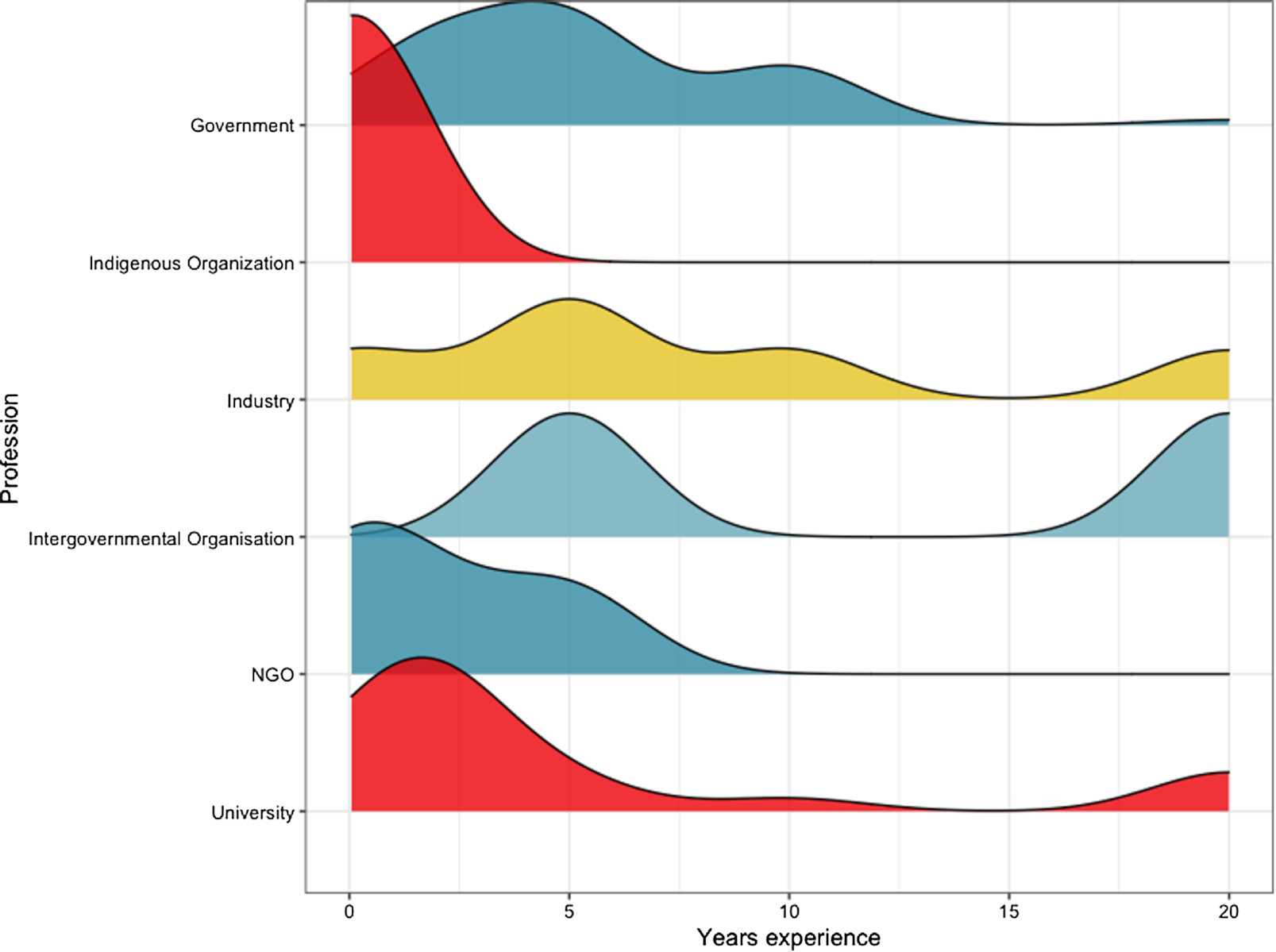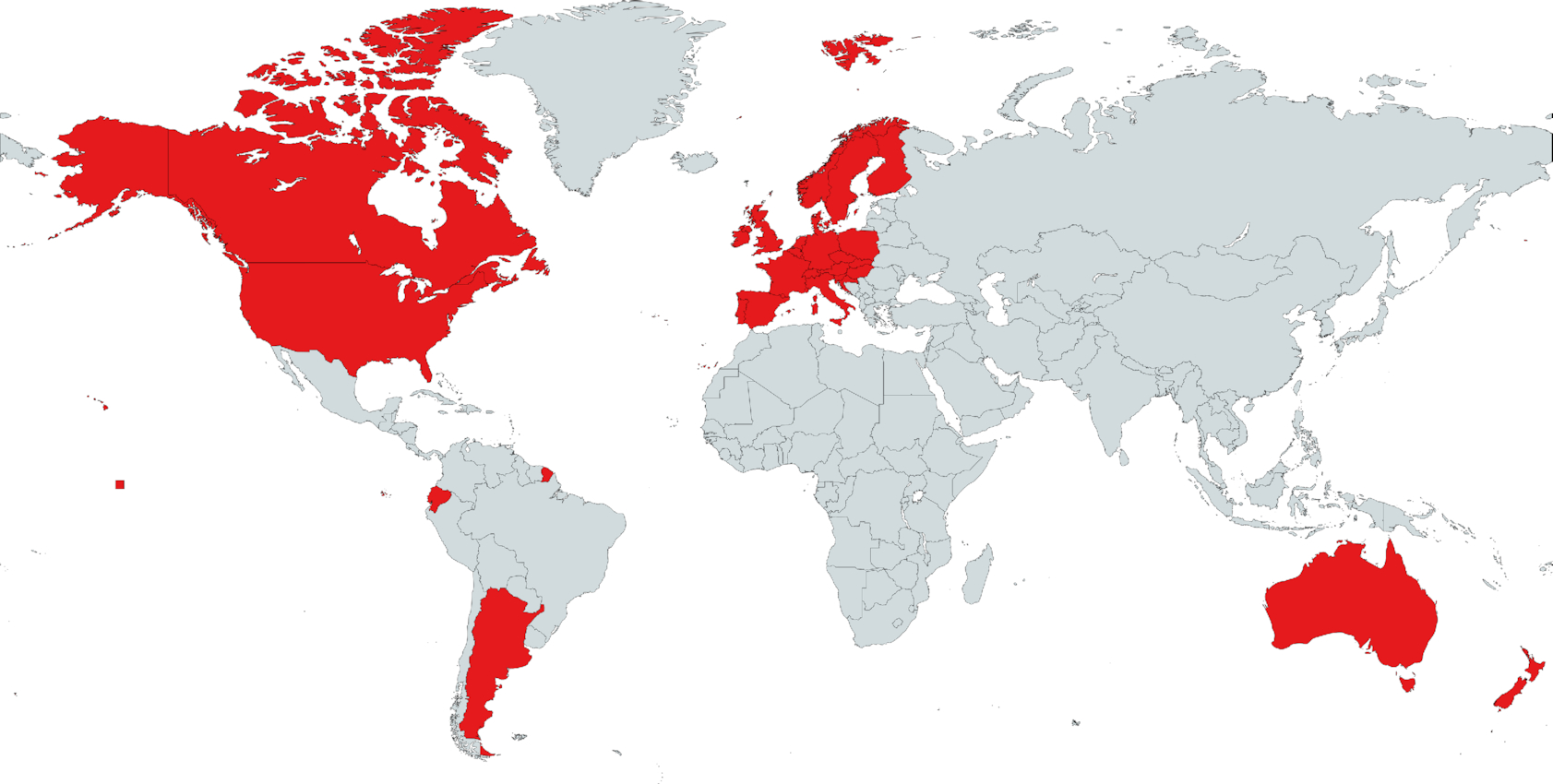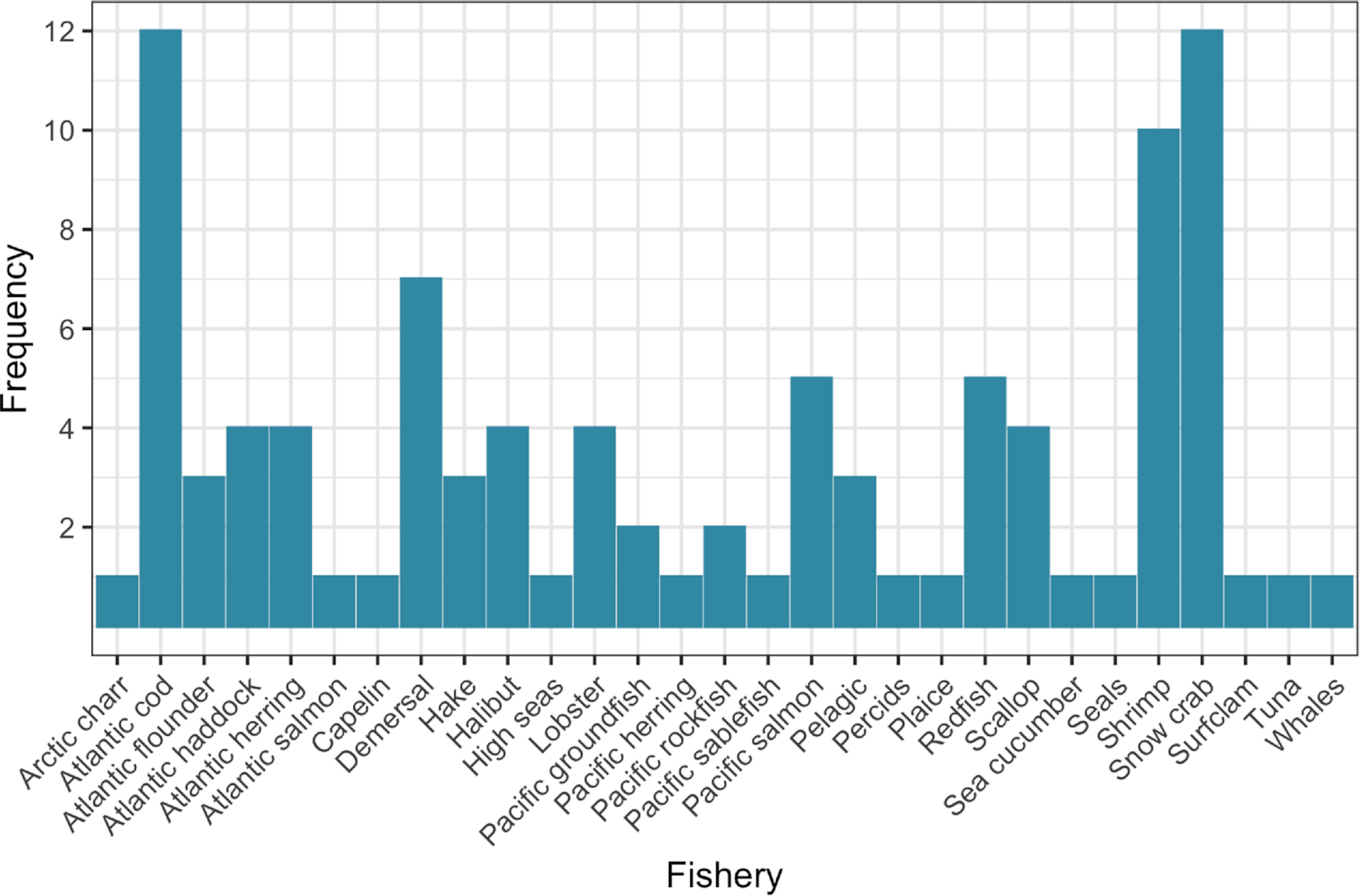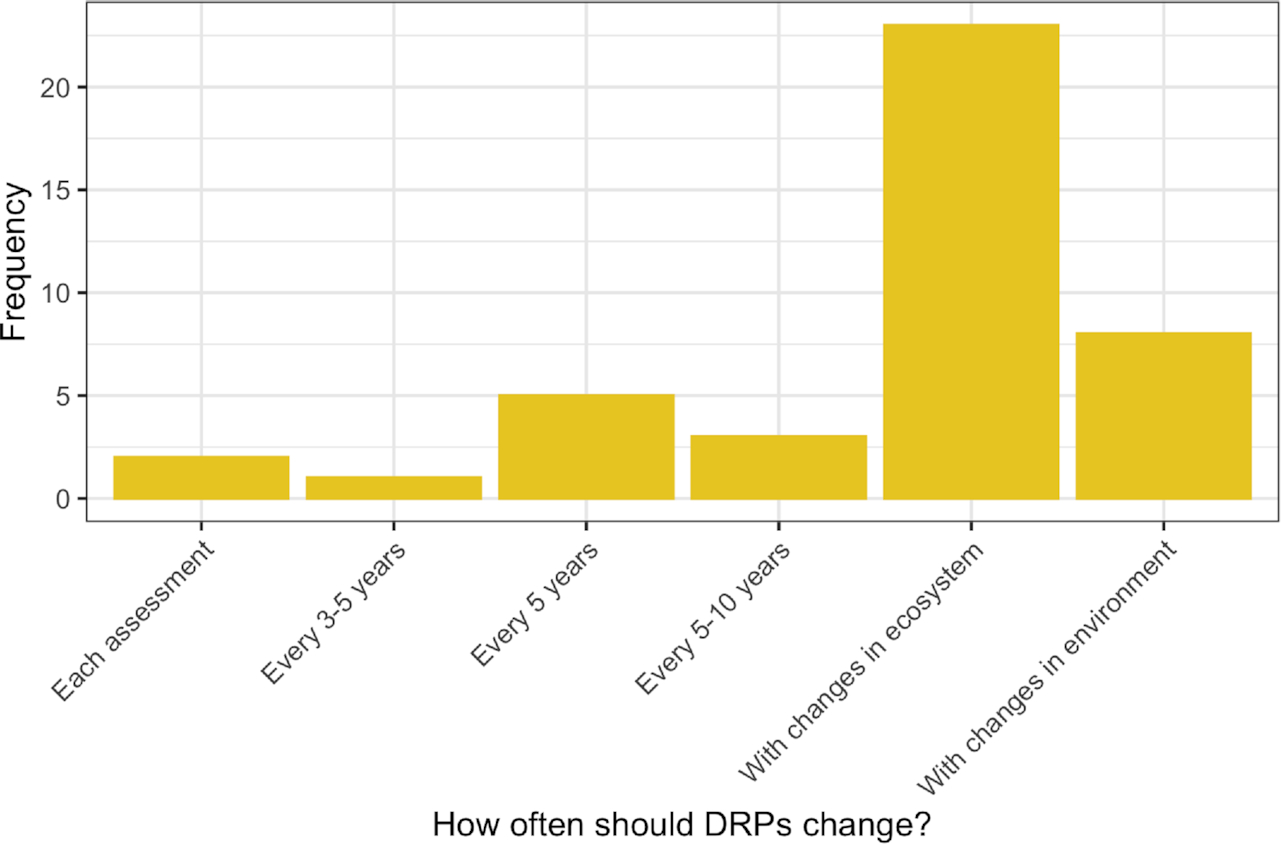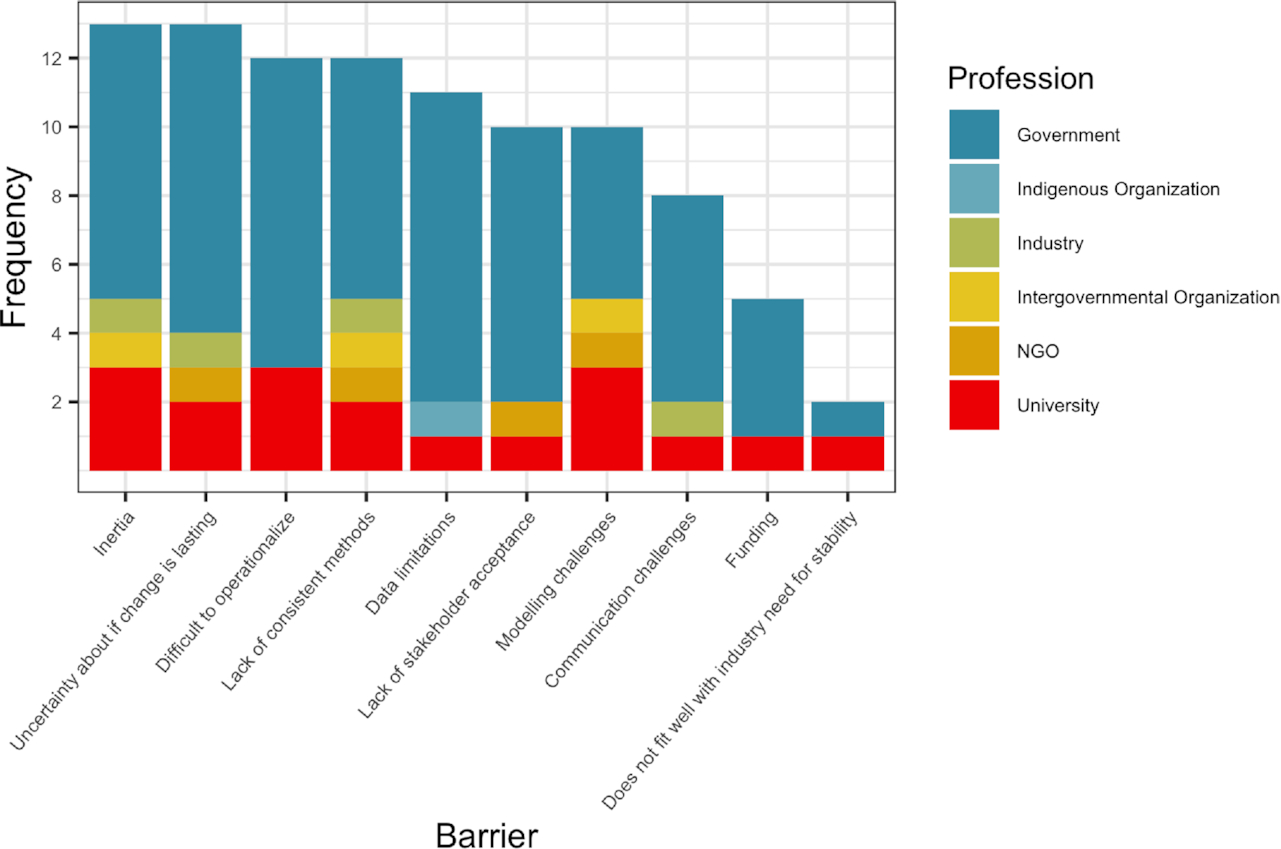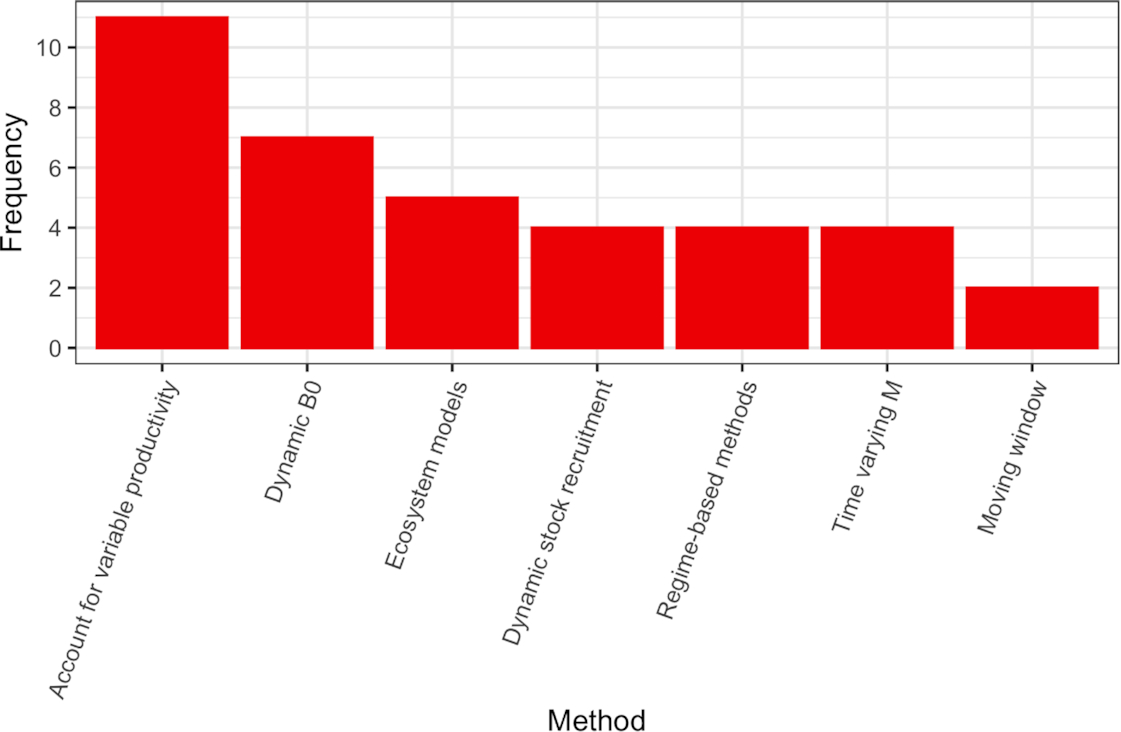Introduction
Fisheries management generally aims to balance economic, social, and ecological goals—the relative importance of each varies according to culture, nation, and ecosystem type (
Worm et al. 2009). Traditionally, fisheries have been managed at the species level (
Hilborn and Walters 1992). Acknowledgement that environmental conditions, habitat, and food web interactions change through time and affect fished species has led toward managing at the ecosystem scale, referred to as ecosystem-based fisheries management (EBFM) (
Fulton 2021;
Howell et al. 2021;
Link and Marshak 2021). In some cases, it has been speculated that collapse of fish stocks could have been prevented if EBFM had been in place (
Lindegren et al. 2009). From a scientific perspective, challenges with implementing EBFM in dynamic systems lie in the detection of changes in the system and prediction of its future state (
Travis et al. 2014;
Dempsey et al. 2018). From a management perspective, challenges lie in how to respond to dynamic systems in a timely fashion to achieve management goals and to balance management performance and stability (
Townsend et al. 2019;
Collie et al. 2021;
Kasperski et al. 2021;
Spence et al. 2021).
Reference points are tools to quantify management objectives, which often include target and limit reference points of resource biomass and associated fishing pressure (
Caddy and Mahon 1995). Reference points help to define fisheries sustainability by balancing fisheries yield, sustainability, and conservation objectives (
Carpenter et al. 2017). Fisheries stock assessments evaluate whether fish stock biomass has increased or decreased from previous assessments based on fisheries catch data, fisheries-independent survey data (when available), and ecosystem data (when available). Unfished biomass (
B0) is a commonly used reference point, often with a target to maintain fish stock biomass at 40%–60% of
B0 and with a limit reference point to maintain biomass above 20%–30%
B0. Biomass at maximum sustainable yield (
BMSY)—the biomass level that maximizes long-term stock productivity, typically about 50%
B0—has also traditionally been used as a target reference point (
Hilborn and Walters 1992;
Worm et al. 2009). Associated with target reference points are the corresponding fisheries exploitation rates (
u) to achieve them, commonly represented as fisheries mortality (
F) in population dynamics models (
Hilborn and Walters 1992). Estimating biomass reference points for species with highly variable abundance and recruitment dynamics provides a challenge, and choice of reference point estimation method should consider species life history (
Haltuch et al. 2009).
Fish stocks naturally fluctuate through time; of concern for setting reference points are trends in abundance and regime shifts (
Klaer et al. 2015). Traditional practice derives reference points from equilibrium assumptions of population dynamics that are constant through time. However, there is increasing evidence that population dynamics can exhibit multiple equilibrium states, especially in response to climate change and ecosystem regime shifts (
Szuwalski and Hollowed 2016;
Zhang et al. 2018;
Tang et al. 2021), or that they are cyclical or dynamic through time (
Bakun et al. 2010). Traditional static reference points that assume stationary population dynamics can change over time when recalculated with updated data about vital rates (
Berger 2019). Allowing reference points to vary through time to account for shifts in ecosystem and species population productivity may be necessary to realize fishery sustainability (
Szuwalski and Hollowed 2016). We refer to the process of allowing changes in reference points over time as
dynamic reference points.
Dynamic reference points differ from static reference points in the ability to incorporate non-stationary population dynamics and track time-varying population vital rates (e.g., population productivity;
Berger 2019). Dynamic reference points can be implemented by either accounting for dynamic unfished biomass (
B0) or by using dynamic fisheries exploitation rates (
u and
F) (
Punt et al. 2014;
King et al. 2015). Dynamic
B0 is calculated by running a model without fisheries catch removals after population dynamics and fisheries mortality parameters have been estimated, making the crucial assumption that recruitment deviations and other model parameters are not density-dependent (
Berger 2019). Dynamic
B0 can also be estimated using time-varying parameter estimates from a stock assessment (e.g., recruitment deviations and natural mortality;
MacCall et al. 1985). Dynamic
F can be set based on an understanding of the stock productivity, which is influenced by environmental conditions, ecosystem productivity, and predator–prey interactions (
Howell et al. 2021). Recent advances in state-space modelling for fisheries stock assessment provide an approach to estimate key time-varying population rates (e.g.,
Peterman et al. 2000;
Peterman et al. 2003;
Minto et al. 2013;
Pedersen and Berg 2017;
Holt and Michielsens 2020;
Zhang et al. 2020), making it possible to generate dynamic reference points that track changes in population productivity (
Collie et al. 2021). Other methods define recent population state based on a truncated time-series of recruitment (i.e., moving window, the sequential
t test analysis of regime shifts (STARS) (
Rodionov 2004;
Rodionov and Overland 2005), with the trade-off that truncating a time-series introduces additional uncertainty and removes information from the analysis (
van Deurs et al. 2021). Ecosystem model simulations can be used to produce ecosystem fishing morality values (
Feco) to keep fishing intensities within predetermined ecosystem indicator limits (
Howell et al. 2021). Finally, dynamic reference points have been created using covariates that define prevailing environmental conditions—although situations where environmental mechanisms are known are rare (i.e.,
Punt et al. 2014;
Hill et al. 2019). Despite the existence of these methods, the practical application of dynamic reference points in fisheries management remains a challenge.
While there have been advances in approaches to calculate dynamic reference points, they may not always perform as well as static reference points (
A’mar et al. 2009;
Haltuch et al. 2009;
Haltuch and Punt 2011;
Punt et al. 2014;
Berger 2019;
O’Leary et al. 2020;
Punt et al. 2021). Dynamic reference points typically outperform static reference points when there is a directional change in fish stock productivity, while static reference points are better suited to non-directional variability in population dynamics (
Berger 2019). For example, west coast U.S. groundfish stock status indicators mostly varied by less than 10% when calculated with static vs. dynamic
B0 approaches; however, in some cases status differed by as much as 72%, which would trigger different management actions (
Berger 2019). Detecting a regime shift to trigger a change in reference point can be problematic, and attributing the mechanism of regime shift—abundance or spawning biomass driven vs. environment driven—is often difficult but important to inform the type of management action to be taken (
Szuwalski 2013;
Vert-pre et al. 2013a,
2013b;
Punt et al. 2014;
Klaer et al. 2015).
Here, we address whether dynamic reference points should be used, how and where they have been applied, and why they are not more widely used in fisheries management. To this end, we designed an online survey to ask fisheries scientists, industry stakeholders, Indigenous partners, and non-governmental organizations (NGOs) whether changing ecosystem productivity was a problem in their experience and how often dynamic approaches to fisheries reference points have been employed. We describe respondent background and experience, fisheries where dynamic reference points have been used, philosophy for their use, and methods to implement them. We also report the barriers to implementation of dynamic approaches in fisheries management. The aims of this study are to gain insight into how often dynamic reference points are implemented, the methods employed to do so, and explore reasons why they may not be used in situations where they could be useful.
Methods
We solicited experts and stakeholders that were invited to attend an online workshop on “Fisheries Management Reference Points in Highly Dynamic Ecosystems” from 25–29 January 2021 (
Zhang et al. 2021) to participate in an online survey. The purpose of the workshop was to provide a general overview of the theory and implementation of dynamic reference points to inform fisheries management. We allowed snowball sampling by encouraging invitees to invite additional experts and stakeholders to respond between January 15, 2021 – March 31, 2021 (purposive sampling;
Penrod et al. 2003). The purpose of the survey was to gain insight about respondent experience with dynamic reference points, fisheries where they had been implemented, methods used, and barriers to their implementation. We targeted individuals working in the field of dynamic reference points, although we acknowledge that not every expert was surveyed. Among respondents, we had good global coverage for countries that utilize dynamic reference points and consider our results generally representative; however, as with any sampling methodology, biases exist. Due to the location of the workshop and its hosts being based in Canada, we received more responses from Canadians, potentially overemphasizing a Canadian dynamic reference point perspective. While lack of internet access could prevent respondents from being able to participate in an online survey, we assumed that most active fisheries scientists providing reference points had access.
The survey had 18 questions about participant professional background, experience with dynamic reference points, philosophy on dynamic reference points, implementation of dynamic reference points, and methods to implement dynamic reference points (see
Table 1 for complete list of questions). We received approval to conduct this survey from the Interdisciplinary Committee on Ethics in Human Research, Memorial University (ICEHR #20211291-MI). Not all questions were answered by all respondents (i.e., respondents who had no experience providing reference points did not answer questions that asked for details about which stocks and methods they had experience with).
As above, there are different ways that dynamic reference points can be implemented—by accounting for variable B0 or by updating static B0. For the purposes of the survey, we did not differentiate between the two approaches; however, respondents were asked to provide methods to implement dynamic reference points. We explored whether respondent background and fisheries that respondents had provided reference points for explained variance in survey responses.
Discussion
The results of our survey indicated that there are a variety of scientific methods that have been used to implement dynamic reference points for fisheries management in many countries. The high proportion of respondents who indicated that changing ecosystem or fisheries productivity had been an issue in their experience (96%), and the low proportion who had observed any or frequent use of dynamic reference points (16% and 10%, respectively), suggests that there are barriers to their implementation. We acknowledge that some important fishing nations were not represented in our survey likely biasing our results, including Chile, Japan, Peru, and South Africa, that accounted for approximately 15% of global catches in 2018 (
Pauly et al. 2020). However, most fishing nations that employ reference points were represented. We also acknowledge that tropical nations and fisheries were not well surveyed, indicating that our results are not representative of these regions and fisheries.
Institutional inertia and uncertainty whether a change was lasting were the two most frequently provided barriers. Institutional inertia can manifest through inertia in science (refusal of a new and improved assessment method, e.g.,
Berger et al. 2017) or in management (continual use of the same harvest strategy (i.e.,
Soomai 2017;
Fulton 2021). There are trade-offs between management stability and management performance. Stability can be used as a metric of management performance, as it facilitates the implementation of management policies, maintains the credibility of management agencies, and allows for long-term planning by industry (
Walters and Martell 2005). Institutional inertia that reduces decision space comes from both science and management, and initial scientific inertia may be compounded by managers or miscommunication between science and management (
Arkema et al. 2006;
Leslie and McLeod 2007). The scientific threshold of evidence for changing reference points within government departments may be high, and the resistance of the management system to allow large changes translates into a barrier of institutional inertia, resisting changes in reference points.
Survey results indicated that dynamic reference point approaches were only considered 10% of the time. This may be because dynamic reference point approaches are not often seen as necessary for good management of stocks or due to institutional and knowledge barriers to their implementation. Barriers preventing the integration of science into the decision-making process are not new, and decision-makers are more likely to include scientific research when it is considered relevant, credible (i.e., perceived by decision-makers as accurate, valid, and high quality), and legitimate (i.e., free from bias;
Cash et al. 2002). These attributes are more likely to be achieved if collaborative and participatory approaches to knowledge exchange between scientists and decision-making have been applied (
Cash et al. 2002, p. 20;
Clarke et al. 2013).
Overcoming barriers to implementation of dynamic approaches to fisheries management can be achieved by creating a more responsive science-management process, through changes in data collection, stock assessment, and harvest control rule/catch advice formulation (
Link et al. 2021). These measures may not be able to reduce uncertainty associated with if a change in productivity is lasting, which was tied for the most identified barrier; however, they may promote early detection of, and rapid response to, changes. For example, shifts in population productivity can be identified based on changes in population life-history characteristics (i.e., age at maturity, size at age for Atlantic cod and American plaice in Canada;
Morgan et al. 2014). Ensuring that these data collection programs are in place can provide indicators to identify changing productivity. Additionally, stock assessments can be modified to include mechanisms that drive productivity (i.e., US west coast sablefish;
Schirripa et al. 2009), parameters that vary over time (i.e., Atlantic cod, Canada;
Minto et al. 2013;
Zhang et al. 2020), or by using truncated time-series to estimate recruitment (i.e., Pacific salmon, herring, and pollock in Alaska;
Rodionov 2004). Running single-species fisheries mortality targets in ecosystem models can provide strategic insight about whether ecosystem level thresholds will be exceeded, and if so, fishing mortality targets can be rescaled to ecosystem targets (
Feco; i.e., Atlantic menhaden in the US and Atlantic cod, herring, whiting, Norway lobster, crabs, and scallops in the Irish Sea;
Howell et al. 2021). Managers may also create a more responsive science-management process by modifying harvest control rules in response to changes in environmental variables or by modifying the allowable catch based on current estimates of stock or ecosystem productivity (i.e., Pacific groundfish stocks in Alaska; northern shrimp and snow crab in Canada;
Holsman et al. 2020;
Link et al. 2021;
Marentette et al. 2021).
Survey results did not suggest a clear single approach to scientific methods or management actions for dynamic systems, with variability in responses about how often reference points should be changed, the methods that should be used to evaluate changes, how to set reference points, and what scenarios and data requirements are appropriate for such methods. Having a consistent approach may allow for easier implementation for new fisheries; however, the one-size fits all solution may lack the nuance required for fisheries with differing dynamics, data availability, and management structures. Species life history influences population dynamics and can provide advice about which approach may perform best (
Berger 2019). Climate change adds the challenge of managing stocks that migrate across jurisdictional boundaries or are experiencing range shifts, whether they be management units within a country or across national borders (
Pinsky et al. 2018;
Palacios-Abrantes et al. 2021;
Schuch et al. 2021). Addressing these issues could involve approaches that consider spatially resolved analyses (
Berger et al. 2017).
Fish populations and ecosystems change through time, are presently being affected by climate change, and projections indicate exacerbated impacts as greenhouse gas emissions continue to increase (
IPCC 2019). Fisheries management agencies are increasingly including environmental information in decision-making (
Kulka 2022;
Pepin et al. 2022). However, given the gap between the number of instances where changing ecosystem productivity was identified as a problem and the number of times that dynamic reference points were implemented, addressing barriers to implementation may be a way for management agencies to respond to highly dynamic ecosystems. There is no consensus on the scenario that warrants dynamic reference point use and how to apply them; however, there are now methods and case studies that we can look to when considering how to effectively manage fisheries in dynamic ecosystems.
